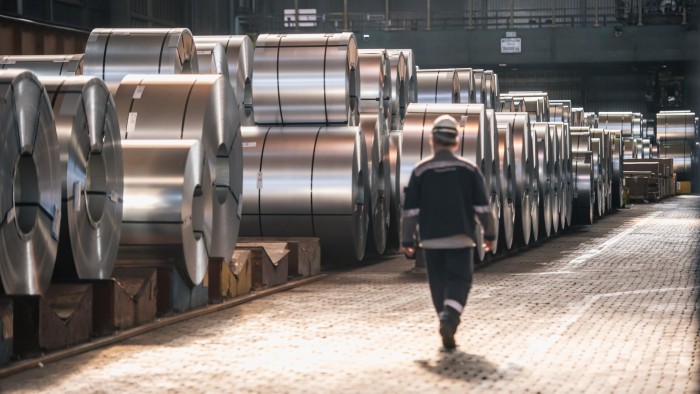Stay informed with free updates
Simply sign up to the EU trade myFT Digest — delivered directly to your inbox.
Europe is being flooded with steel diverted from the US because of high tariffs, with imports of certain products increasing tenfold since the start of the year, according to a new monitoring system.
Europe’s steel industry has called for Brussels to take urgent measures as the import surge is expected to suppress prices in the EU.
“The time for action is now,” Ilse Henne, chair of the supervisory board of Thyssenkrupp told the FT.
The warning came as the European Commission issued its first surveillance report to detect surges in imports after Donald Trump returned to the White House threatening tariffs. It found massive increases in import volumes and steep price drops for a range of products, ranging from guitars to industrial robots since January 1.
Imports of stainless steel bars and rods were up by more than 1,000 per cent year on year, with prices down 88 per cent. Other steel bars and rods were up 222 per cent while prices dropped 55 per cent.
“With this new import surveillance tool we are boosting our capacity to protect our own interests and stop surges in imports diverted to our market,” said Maroš Šefčovič, EU trade commissioner
Electric guitar imports were up almost 500 per cent and prices fell by four-fifths while industrial robots grew by 315 per cent, with prices down by a third.
Big increases were also reported in plywood, aluminium foil and spirits.
A heat map in the report showed that China was the source of big surges in machinery, textiles, chemicals, and wood and paper.
A big jump also occurred in imports of food, drinks and chemicals from the US, as companies stocked up before EU retaliatory tariffs hit.
Analysts cautioned that the automated customs data was imprecise because products with very different prices were included in the same category, so consumers could also be trading down.
However, Henne said the threat to the steel industry was real. The EU has had safeguard measures in place since 2016 which imposes 25 per cent tariffs on imports above a quota, but they are being eased ahead of their expiry in 2026.
Šefčovič promised on Thursday that he would propose a replacement system by this summer.
Henne said a plan to support the industry by cutting energy prices and prioritising domestic production in public contracts should be advanced quickly.
“Companies from outside the EU must meet the same climate, market openness and competition standards — or we risk undermining our own resilience,” she said.
She also called for tariffs on Russian steel imports. While finished and semi-finished products were banned after the 2022 invasion of Ukraine steel slab was exempted.
Henne said Thyssenkrupp was reducing its production capacity from 11mn to 9mn tonnes annually because of weak demand, resulting in thousands of job losses.
The US put 50 per cent tariffs on steel and aluminium this week, doubling the 25 per cent levies on the sectors that the US president had introduced in March.
Eurofer, the industry body, said on Thursday that EU steel consumption would drop by 0.9 per cent in 2025, the fourth year of recession. Imports continue to grow however, it said.
“In light of the continuous worsening of the EU steel market outlook, we call on the European Commission to consider emergency trade actions to ensure the stability of the EU steel market,” said Axel Eggert, Eurofer’s director-general.

